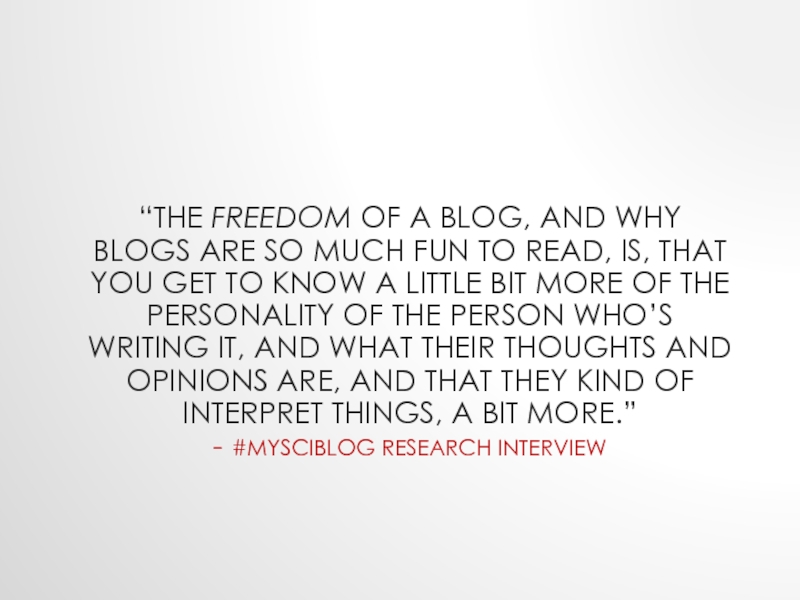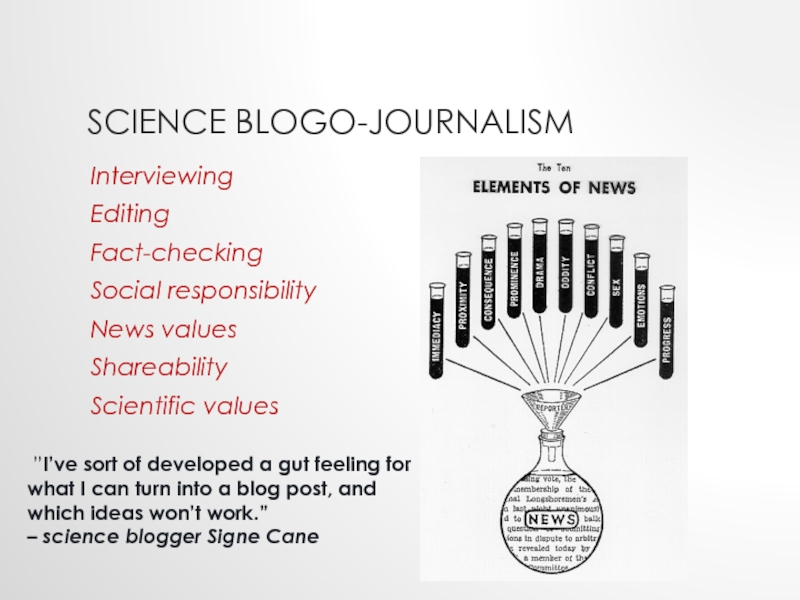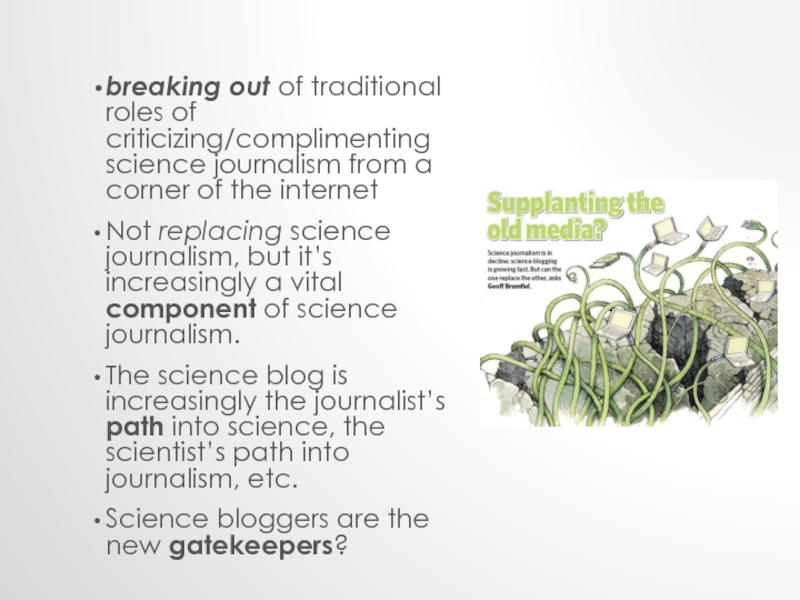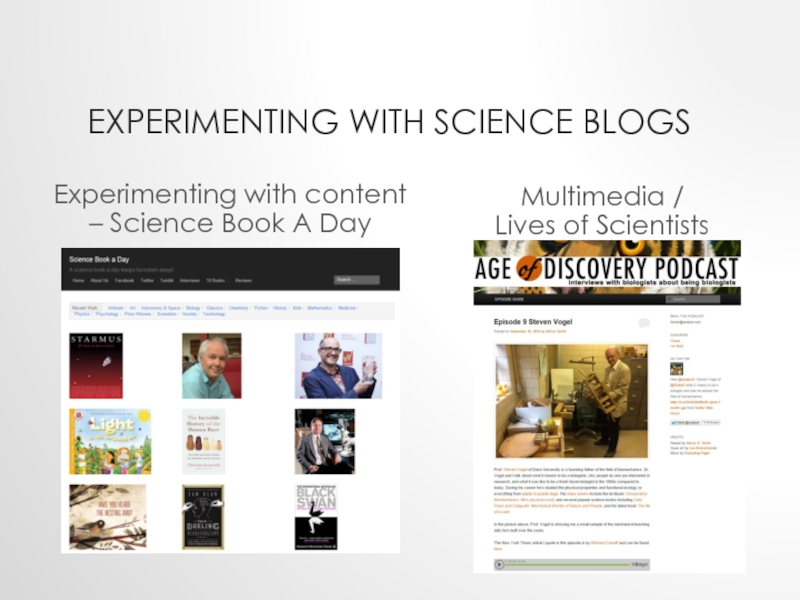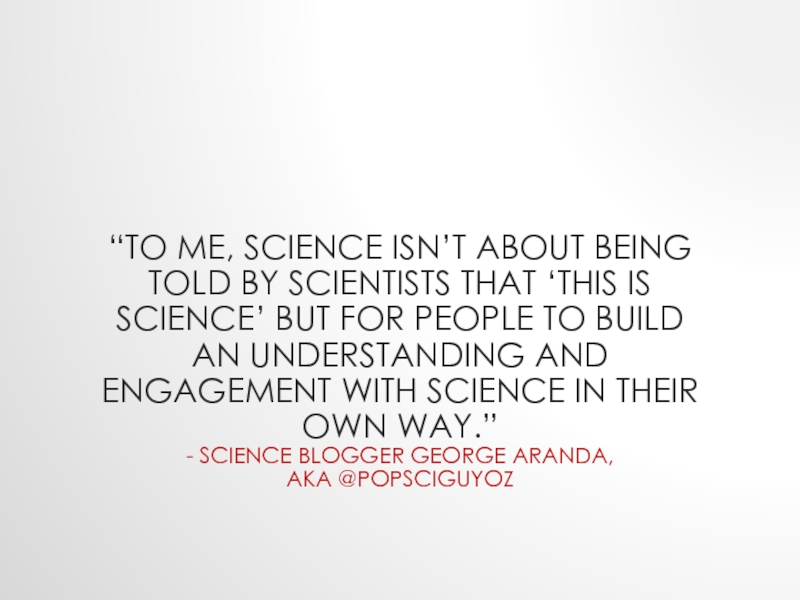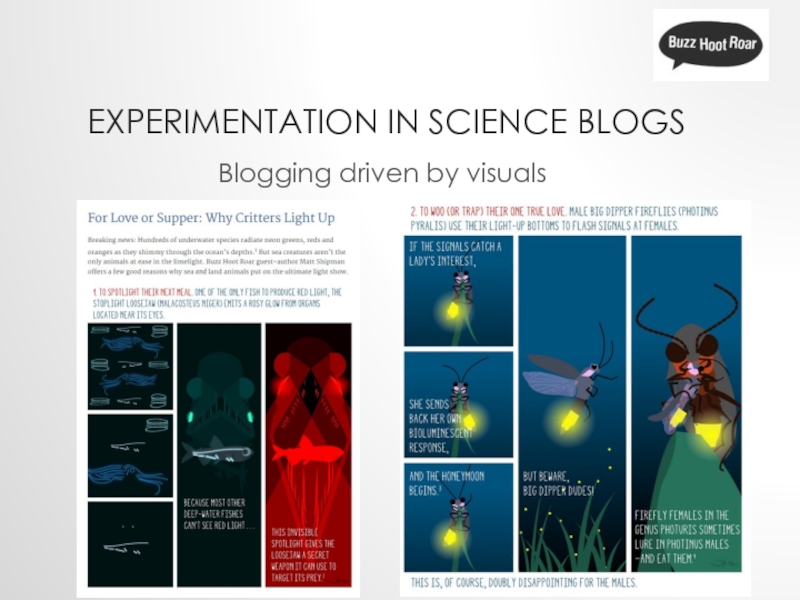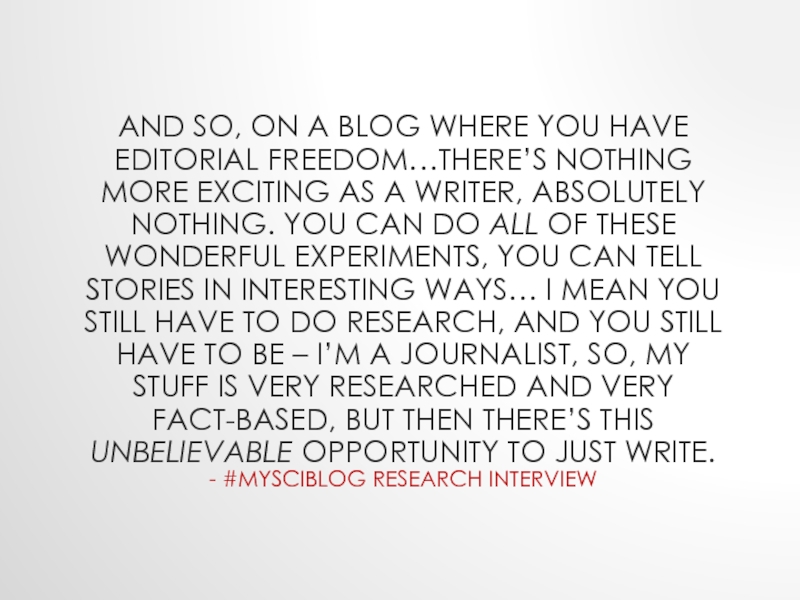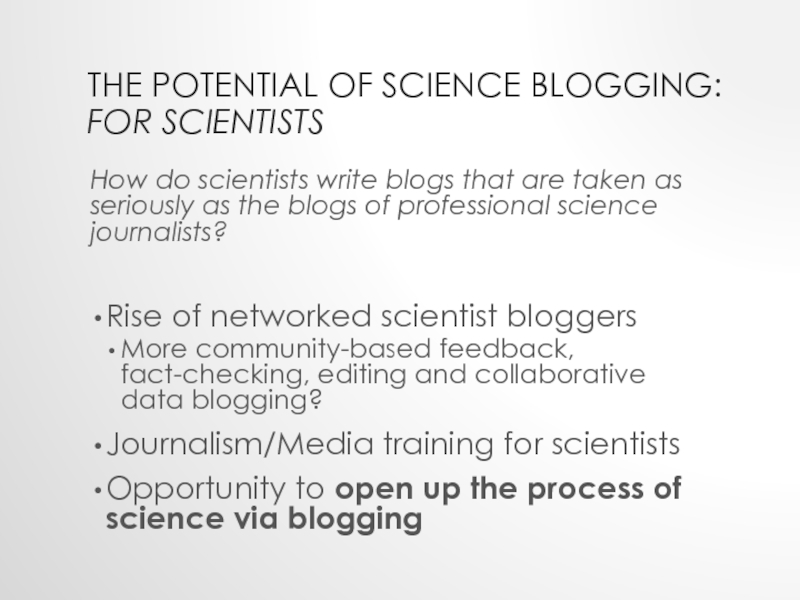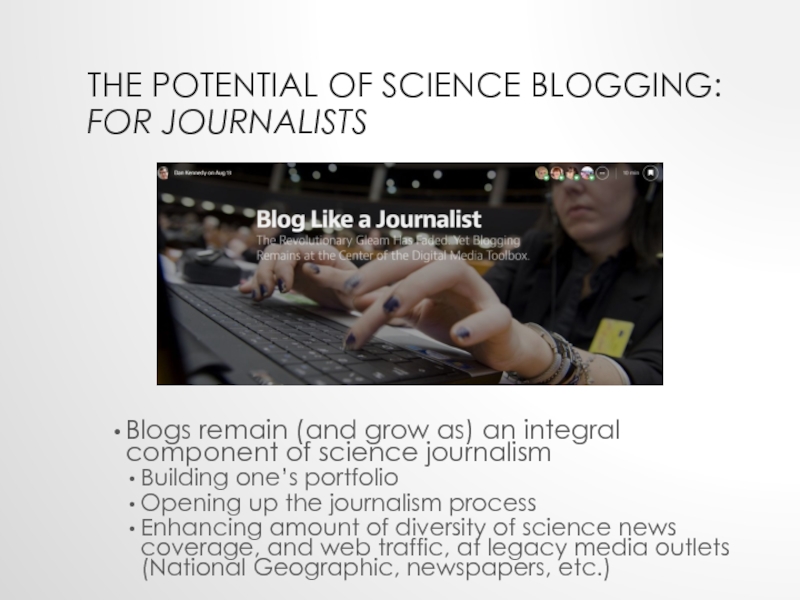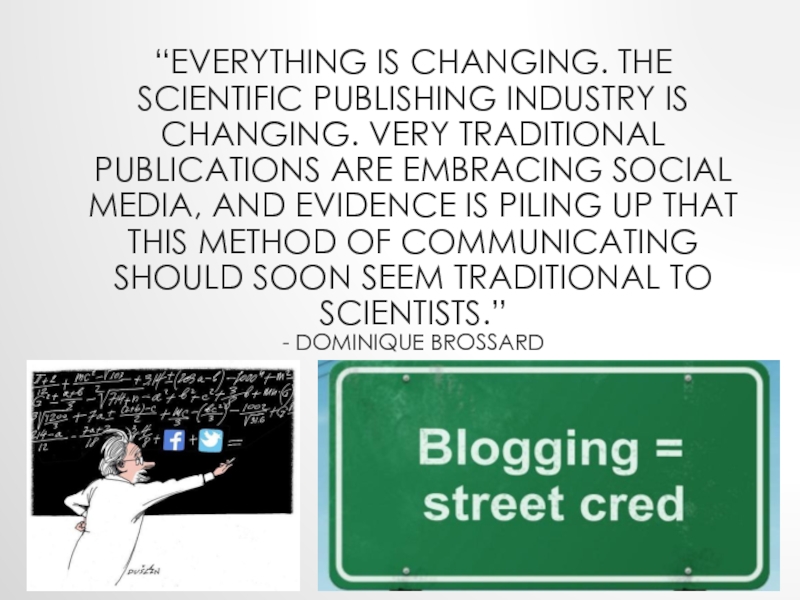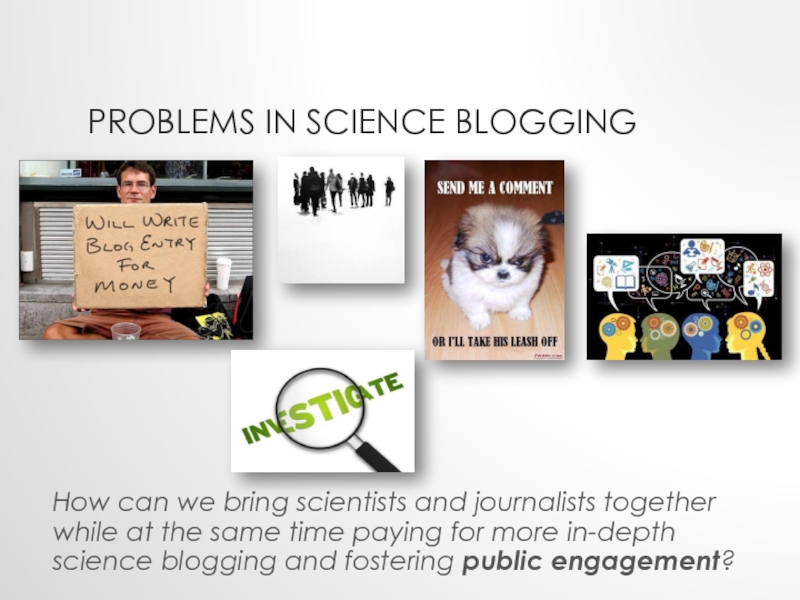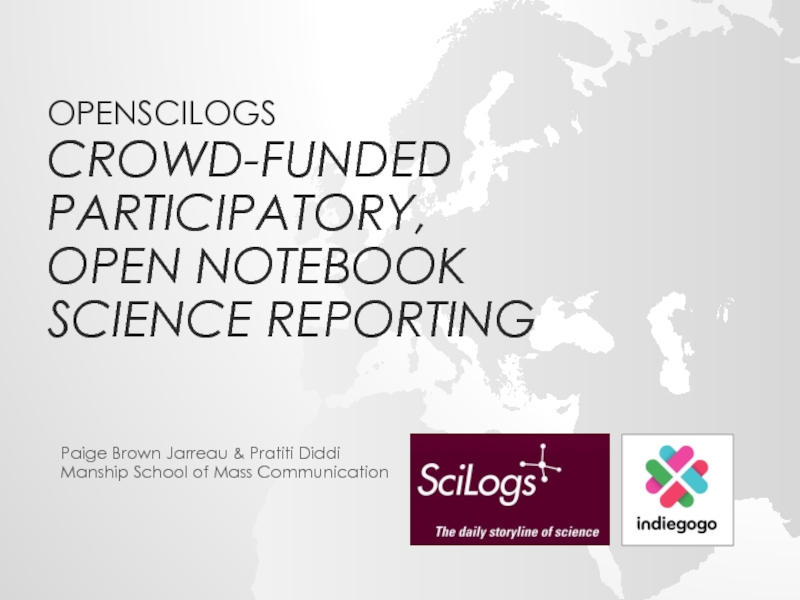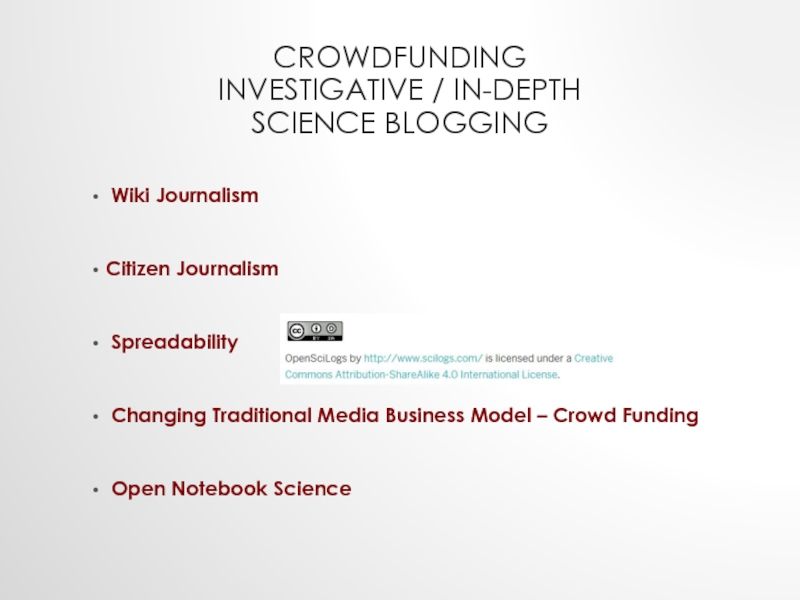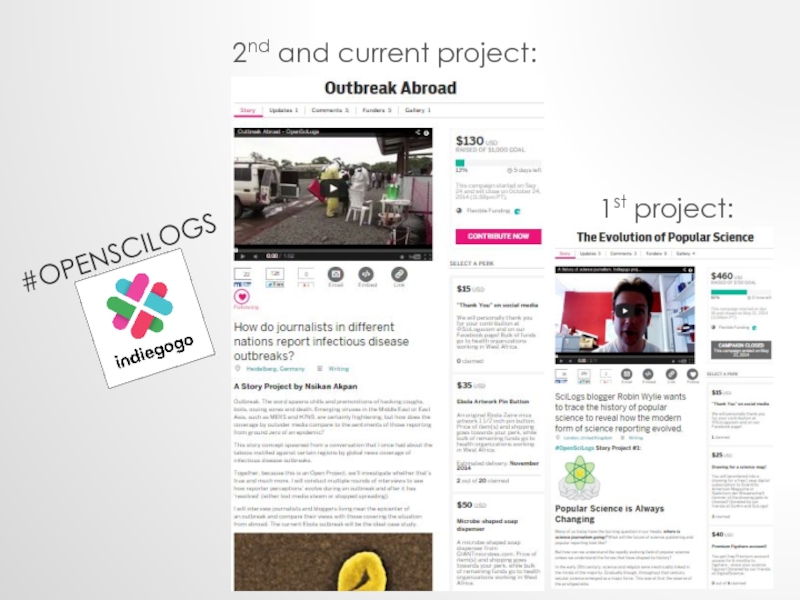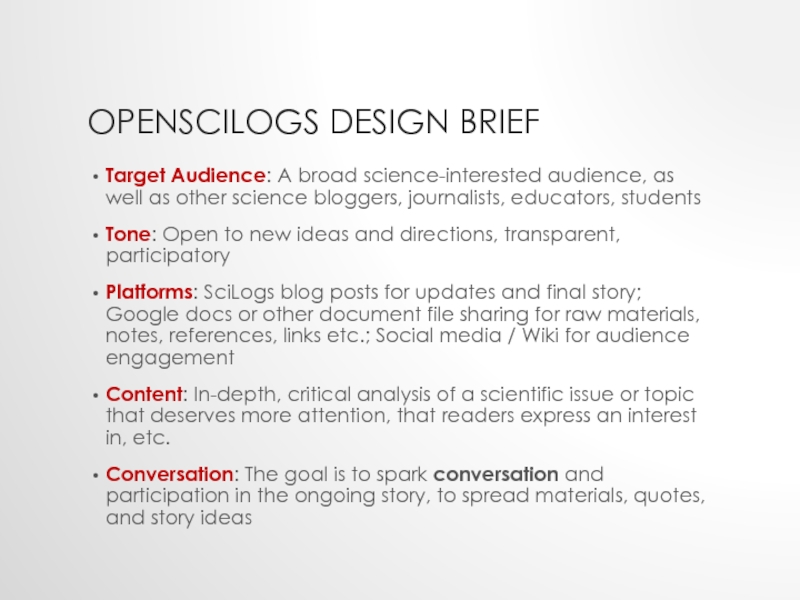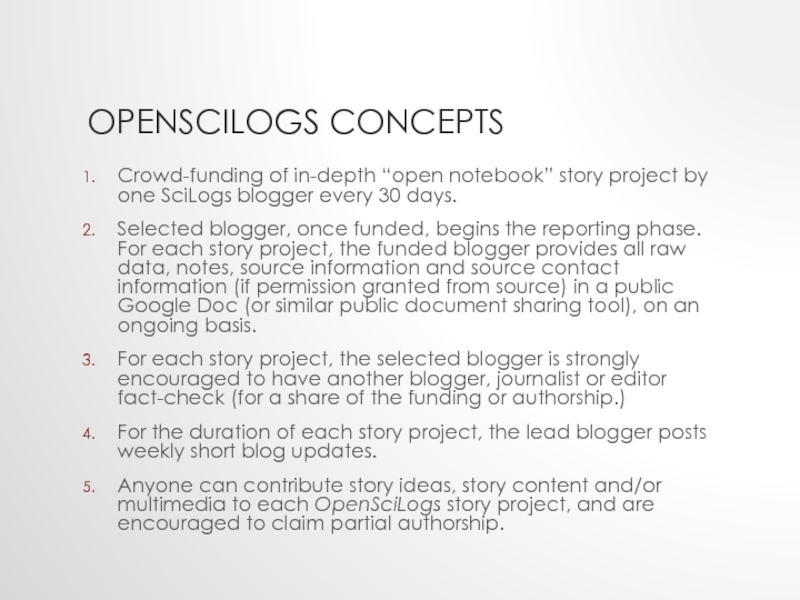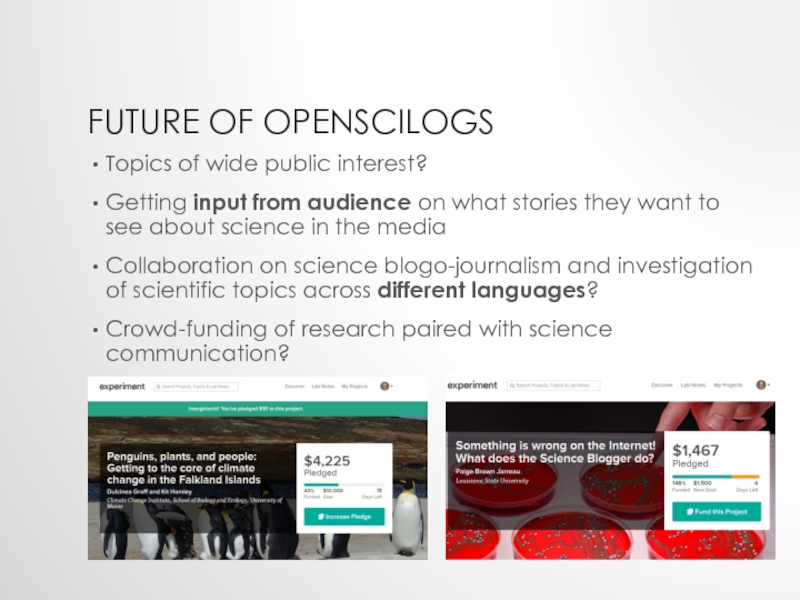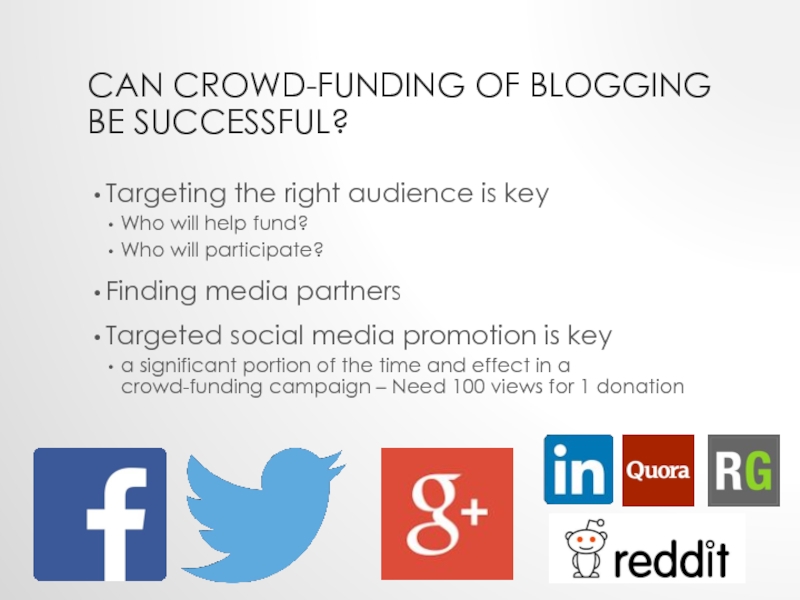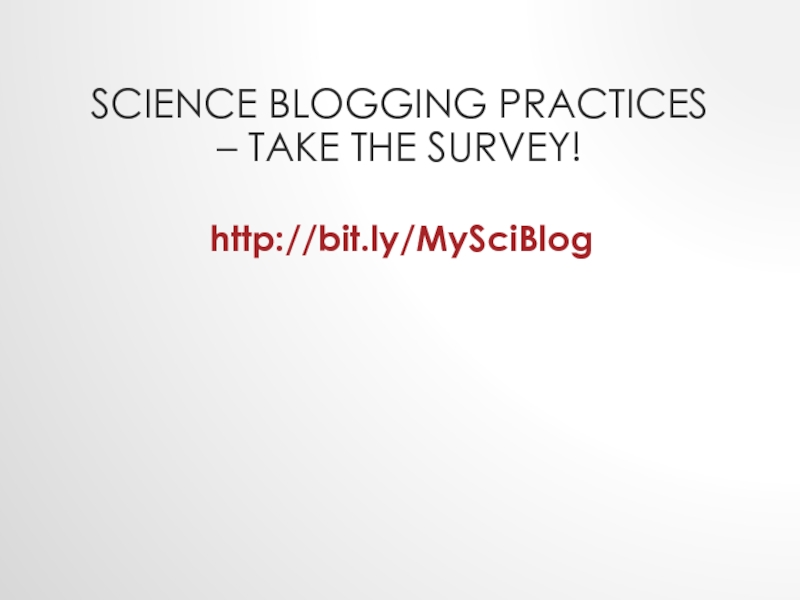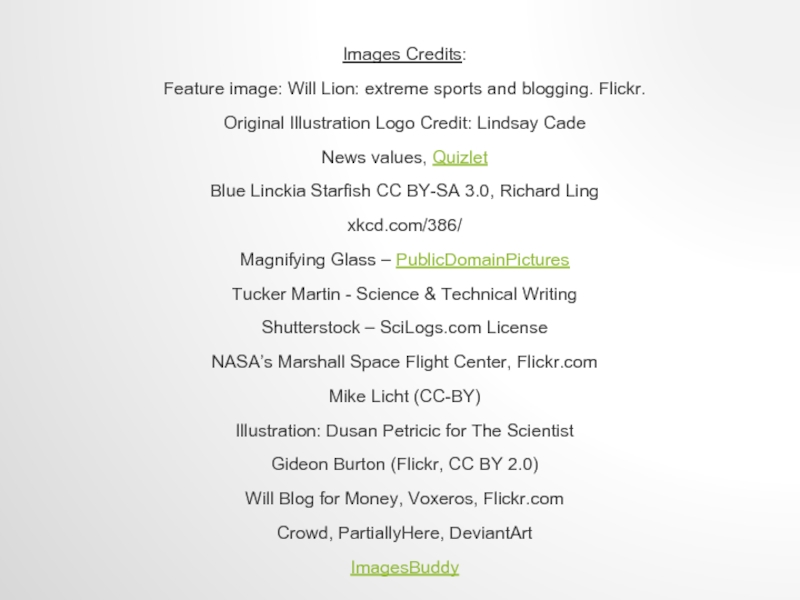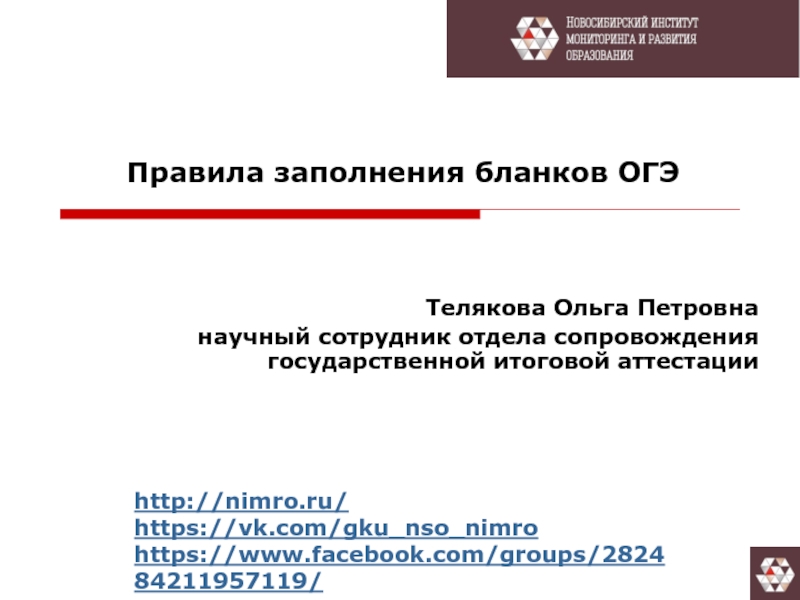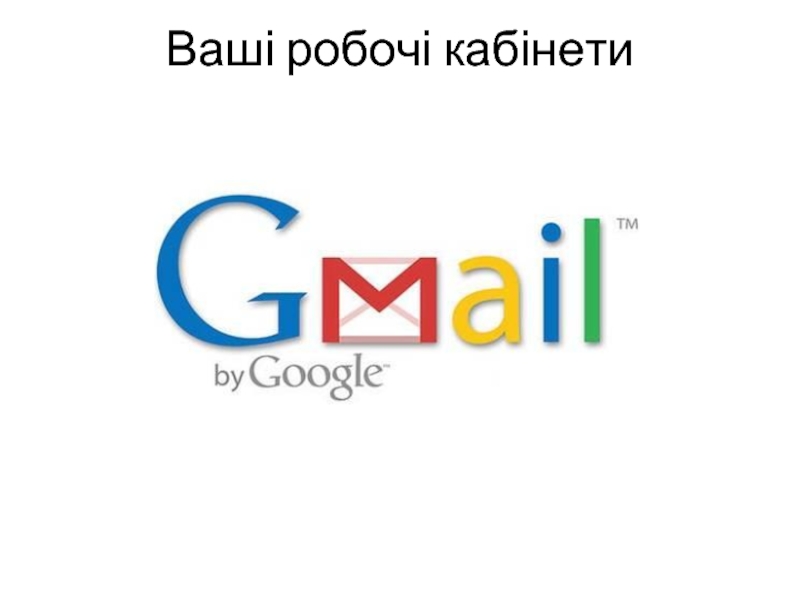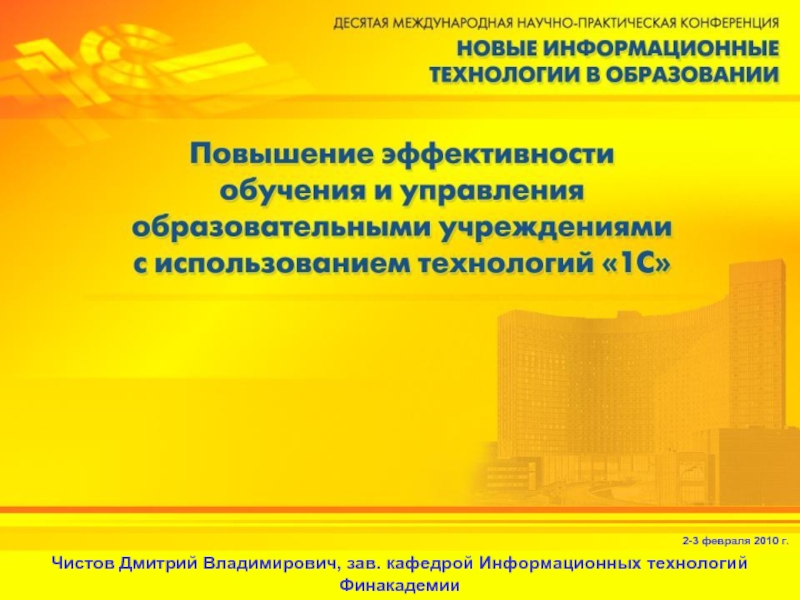- Главная
- Разное
- Дизайн
- Бизнес и предпринимательство
- Аналитика
- Образование
- Развлечения
- Красота и здоровье
- Финансы
- Государство
- Путешествия
- Спорт
- Недвижимость
- Армия
- Графика
- Культурология
- Еда и кулинария
- Лингвистика
- Английский язык
- Астрономия
- Алгебра
- Биология
- География
- Детские презентации
- Информатика
- История
- Литература
- Маркетинг
- Математика
- Медицина
- Менеджмент
- Музыка
- МХК
- Немецкий язык
- ОБЖ
- Обществознание
- Окружающий мир
- Педагогика
- Русский язык
- Технология
- Физика
- Философия
- Химия
- Шаблоны, картинки для презентаций
- Экология
- Экономика
- Юриспруденция
The Future of Science Bloggingand #OpenSciLogs презентация
Содержание
- 1. The Future of Science Bloggingand #OpenSciLogs
- 2. FIRST-THINGS-FIRST: WHAT IS A BLOG? A piece
- 3. THE BLOG RESISTS DEFINITION “[B]logs are now
- 4. WHAT IS SCIENCE BLOGGING? a blog featuring
- 5. WHERE HAVE WE COME FROM? Early 2000’s
- 6. Openness and Spreadability Open Access
- 7. Rise of a science blog ecosystem
- 8. Increasing role of science blogs and social networks (Twitter) in science communication and science news
- 9. 500 recent tweets mentioning “SciLogs” Conversations based
- 10. TRENDS IN SCIENCE BLOGGING Professionalization Science journalism
- 11. Traditional functions Debunking Expert opinions Media Criticism
- 12. "SOME OF THESE SCIENCE BLOGGERS [...] THEY'RE
- 13. WHAT ARE WE BLOGGING ABOUT? http://www.scilogs.com/from_the_lab_bench/science-blogging-got-comments/
- 14. WHAT ARE WE BLOGGING ABOUT? http://www.scilogs.com/from_the_lab_bench/science-bloggers-and-the-long-tail-of-science-writing/
- 15. Bloggers’ strategic choices to deep dive into
- 16. BLOGGING SOMETHING DIFFERENT
- 17. BLOGGING SOMETHING DIFFERENT “[But] "if there's something
- 18. “THE FREEDOM OF A BLOG, AND WHY BLOGS ARE
- 19. SCIENCE BLOGO-JOURNALISM Interviewing Editing Fact-checking Social responsibility
- 20. breaking out of traditional roles of criticizing/complimenting
- 21. EXPERIMENTING WITH SCIENCE BLOGS Multimedia /
- 22. “TO ME, SCIENCE ISN’T ABOUT BEING TOLD
- 23. EXPERIMENTATION IN SCIENCE BLOGS Blogging driven by visuals
- 24. AND SO, ON A BLOG WHERE YOU
- 25. THE POTENTIAL OF SCIENCE BLOGGING: FOR SCIENTISTS
- 26. THE POTENTIAL OF SCIENCE BLOGGING: FOR
- 27. “EVERYTHING IS CHANGING. THE SCIENTIFIC PUBLISHING INDUSTRY
- 28. PROBLEMS IN SCIENCE BLOGGING
- 29. OPENSCILOGS CROWD-FUNDED PARTICIPATORY, OPEN NOTEBOOK
- 30. CROWDFUNDING INVESTIGATIVE / IN-DEPTH SCIENCE
- 31. #OPENSCILOGS 1st project: 2nd and current project:
- 32. OPENSCILOGS DESIGN BRIEF Target Audience: A broad
- 33. OPENSCILOGS CONCEPTS Crowd-funding of in-depth “open notebook”
- 34. FUTURE OF OPENSCILOGS Topics of wide public
- 35. CAN CROWD-FUNDING OF BLOGGING BE SUCCESSFUL? Targeting
- 36. SCIENCE BLOGGING PRACTICES – TAKE THE SURVEY! http://bit.ly/MySciBlog
- 37. Images Credits: Feature image: Will Lion: extreme
Слайд 2FIRST-THINGS-FIRST: WHAT IS A BLOG?
A piece of software / platform?
“a hierarchy
Comments (?)
The “unedited voice of a person” (?)
“less formal, more conversational, often with no traditional reporting (but never without research), and aimed at a small but passionate audience.”
Blog = an online tool for publishing one’s thoughts, stories, news, links, visual materials, etc. in an extended form, on an ongoing basis
http://blogs.law.harvard.edu/whatmakesaweblogaweblog.html
Dave Winer, Scripting News
https://medium.com/@dankennedy_nu/blog-like-a-journalist-8a4acac100c0
Mike Licht (CC-BY)
Слайд 3THE BLOG RESISTS DEFINITION
“[B]logs are now diverse and ubiquitous, and have
The uses and genres of “web blogs” have become so diverse that they have become broadly a “socio-technical format, whose convenience and general utility support a variety of uses.” - Herring et al., Weblogs as a bridging genre, 2005
Слайд 4WHAT IS SCIENCE BLOGGING?
a blog featuring primarily content that disseminates, explains,
Слайд 5WHERE HAVE WE COME FROM?
Early 2000’s – Early blogging, ‘Fighting Pseudoscience’,
~2008 – Diversification of blogging genres – ResearchBlogging
2011 – Rise of blog networks at traditional media organizations (Scientific American, Discover, PloS, etc.)
2012 – Social networks for community building
Today – Blog as the writer’s 'home' online
More attention to the journalist / blogger as 'personality‘
‘Need for Niche’
Слайд 6Openness and Spreadability
Open Access
Spreadable and Creative Commons models
Blogging styles that are
TRENDS IN SCIENCE BLOGGING
Science bloggers are increasingly handing conversations and content over to others, as well as asking for feedback via social media.
Слайд 8Increasing role of science blogs and social networks (Twitter) in science
Слайд 9500 recent tweets mentioning “SciLogs”
Conversations based on blog content have moved
“Today, quick updates, links etc. are done mainly on social media and many bloggers use the traditional blogging software only for longer, more thorough, one could even say more ‘professional’ writing.”
– BoraZ, 2012
We can see different “communities” here
Слайд 10TRENDS IN SCIENCE BLOGGING
Professionalization
Science journalism
Science blogs are where we are working
Слайд 11Traditional functions
Debunking
Expert opinions
Media Criticism
Community building among scientists
Translation of scientific research
New functions
Science
Sources of science news
Curation
Critical analysis
Discussion of science missing from mainstream media
Opening up the science research process
Citizen science, etc.
Adding value and advancing the conversation around scientific issues
xkcd.com/386/
"I spend way [emphasis] more time correcting misinformation than I would like to." #MySciBlog
Слайд 12"SOME OF THESE SCIENCE BLOGGERS [...] THEY'RE BASICALLY DOING WHAT A
Слайд 13WHAT ARE WE BLOGGING ABOUT?
http://www.scilogs.com/from_the_lab_bench/science-blogging-got-comments/
Data from Merja Mahrt and Cornelius
44 bloggers at SciLogs.de
Слайд 14WHAT ARE WE BLOGGING ABOUT?
http://www.scilogs.com/from_the_lab_bench/science-bloggers-and-the-long-tail-of-science-writing/
Science bloggers and the long tail
Слайд 15Bloggers’ strategic choices to deep dive into the under-reported science stories
NASA’s Marshall Space Flight Center, Flickr.com
EXPLOSION OF ALTERNATIVE COVERAGE OF SCIENCE
Слайд 17BLOGGING SOMETHING DIFFERENT
“[But] "if there's something that everyone else is talking
“[P]eople aren't going to come to my blog for the news. They're going to go to a news outlet… So, if I'm going to write about something that's current, it'll only be [if] I can explore something, different about it."
"I couldn't really find out the facts myself, from reading the news, so I thought, I'll go ahead and kind of dig it out..."
"[I] go through lesser-known journals...for little hidden jems...that wouldn't have made it into the news"
“[L]ooking at the other blogs...I think it's important that we cover kind of smaller things that aren't always picked up on"
"I really don’t feel like I’m a slave to the news cycle."
"If I wasn’t going to have all of those crazy resources [and be able to] interview multiple people [...] it had to be DIFFERENT."
#MySciBlog Interviews
Слайд 18“THE FREEDOM OF A BLOG, AND WHY BLOGS ARE SO MUCH FUN TO
Слайд 19SCIENCE BLOGO-JOURNALISM
Interviewing
Editing
Fact-checking
Social responsibility
News values
Shareability
Scientific values
”I’ve sort of developed a gut feeling
– science blogger Signe Cane
Слайд 20breaking out of traditional roles of criticizing/complimenting science journalism from a
Not replacing science journalism, but it’s increasingly a vital component of science journalism.
The science blog is increasingly the journalist’s path into science, the scientist’s path into journalism, etc.
Science bloggers are the new gatekeepers?
Слайд 21EXPERIMENTING WITH SCIENCE BLOGS
Multimedia /
Lives of Scientists
Experimenting with content –
Слайд 22“TO ME, SCIENCE ISN’T ABOUT BEING TOLD BY SCIENTISTS THAT ‘THIS
Слайд 24AND SO, ON A BLOG WHERE YOU HAVE EDITORIAL FREEDOM…THERE’S NOTHING
Слайд 25THE POTENTIAL OF SCIENCE BLOGGING:
FOR SCIENTISTS
How do scientists write blogs that
Rise of networked scientist bloggers
More community-based feedback, fact-checking, editing and collaborative data blogging?
Journalism/Media training for scientists
Opportunity to open up the process of science via blogging
Слайд 26THE POTENTIAL OF SCIENCE BLOGGING:
FOR JOURNALISTS
Blogs remain (and grow as)
Building one’s portfolio
Opening up the journalism process
Enhancing amount of diversity of science news coverage, and web traffic, at legacy media outlets (National Geographic, newspapers, etc.)
Слайд 27“EVERYTHING IS CHANGING. THE SCIENTIFIC PUBLISHING INDUSTRY IS CHANGING. VERY TRADITIONAL
Слайд 28PROBLEMS IN SCIENCE BLOGGING
How can we bring scientists and journalists together
Слайд 29OPENSCILOGS
CROWD-FUNDED PARTICIPATORY,
OPEN NOTEBOOK
SCIENCE REPORTING
Paige Brown Jarreau & Pratiti Diddi
Manship
Слайд 30CROWDFUNDING
INVESTIGATIVE / IN-DEPTH
SCIENCE BLOGGING
Wiki Journalism
Citizen Journalism
Spreadability
Changing
Open Notebook Science
Слайд 32OPENSCILOGS DESIGN BRIEF
Target Audience: A broad science-interested audience, as well as
Tone: Open to new ideas and directions, transparent, participatory
Platforms: SciLogs blog posts for updates and final story; Google docs or other document file sharing for raw materials, notes, references, links etc.; Social media / Wiki for audience engagement
Content: In-depth, critical analysis of a scientific issue or topic that deserves more attention, that readers express an interest in, etc.
Conversation: The goal is to spark conversation and participation in the ongoing story, to spread materials, quotes, and story ideas
Слайд 33OPENSCILOGS CONCEPTS
Crowd-funding of in-depth “open notebook” story project by one SciLogs
Selected blogger, once funded, begins the reporting phase. For each story project, the funded blogger provides all raw data, notes, source information and source contact information (if permission granted from source) in a public Google Doc (or similar public document sharing tool), on an ongoing basis.
For each story project, the selected blogger is strongly encouraged to have another blogger, journalist or editor fact-check (for a share of the funding or authorship.)
For the duration of each story project, the lead blogger posts weekly short blog updates.
Anyone can contribute story ideas, story content and/or multimedia to each OpenSciLogs story project, and are encouraged to claim partial authorship.
Слайд 34FUTURE OF OPENSCILOGS
Topics of wide public interest?
Getting input from audience on
Collaboration on science blogo-journalism and investigation of scientific topics across different languages?
Crowd-funding of research paired with science communication?
Слайд 35CAN CROWD-FUNDING OF BLOGGING BE SUCCESSFUL?
Targeting the right audience is key
Who
Who will participate?
Finding media partners
Targeted social media promotion is key
a significant portion of the time and effect in a crowd-funding campaign – Need 100 views for 1 donation
Слайд 37Images Credits:
Feature image: Will Lion: extreme sports and blogging. Flickr.
Original Illustration
News values, Quizlet
Blue Linckia Starfish CC BY-SA 3.0, Richard Ling
xkcd.com/386/
Magnifying Glass – PublicDomainPictures
Tucker Martin - Science & Technical Writing
Shutterstock – SciLogs.com License
NASA’s Marshall Space Flight Center, Flickr.com
Mike Licht (CC-BY)
Illustration: Dusan Petricic for The Scientist
Gideon Burton (Flickr, CC BY 2.0)
Will Blog for Money, Voxeros, Flickr.com
Crowd, PartiallyHere, DeviantArt
ImagesBuddy

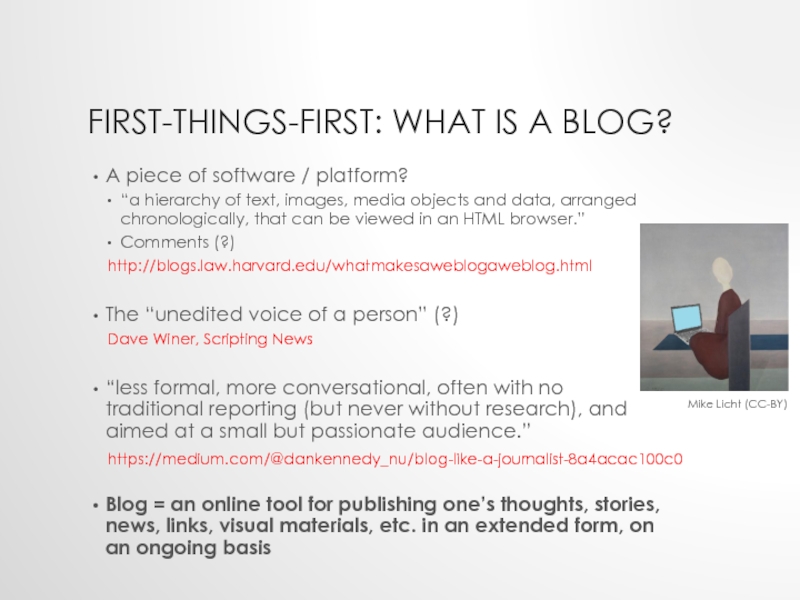
![THE BLOG RESISTS DEFINITION“[B]logs are now diverse and ubiquitous, and have hit the mainstream.” –](/img/tmb/1/90809/814c1cc174dfa34442e6c8f6d3a9f182-800x.jpg)
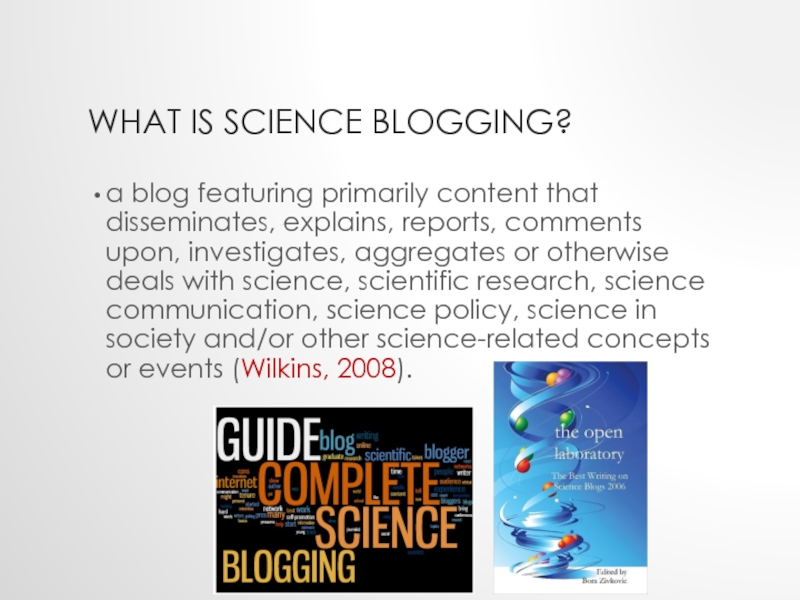
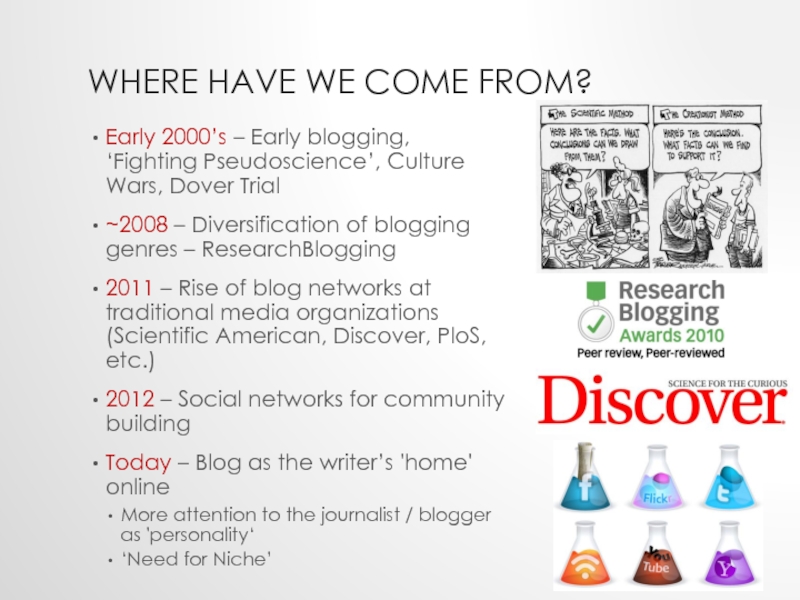
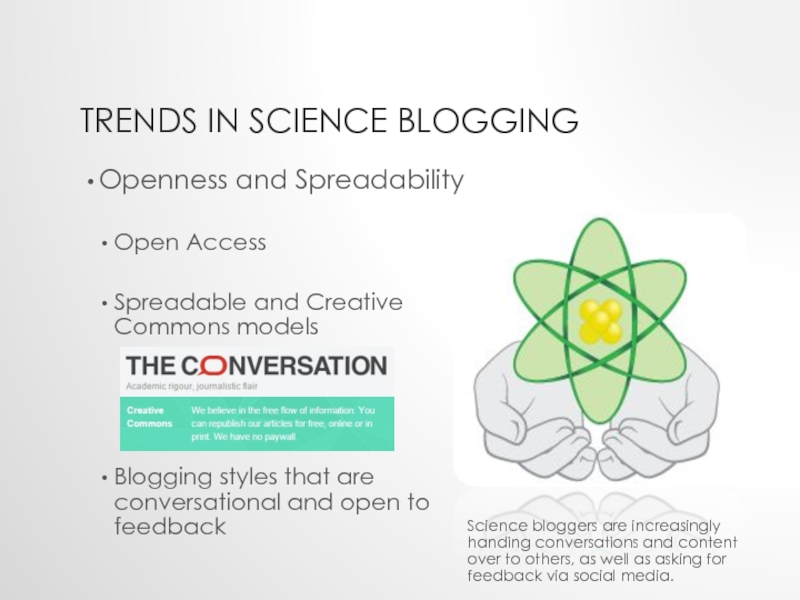
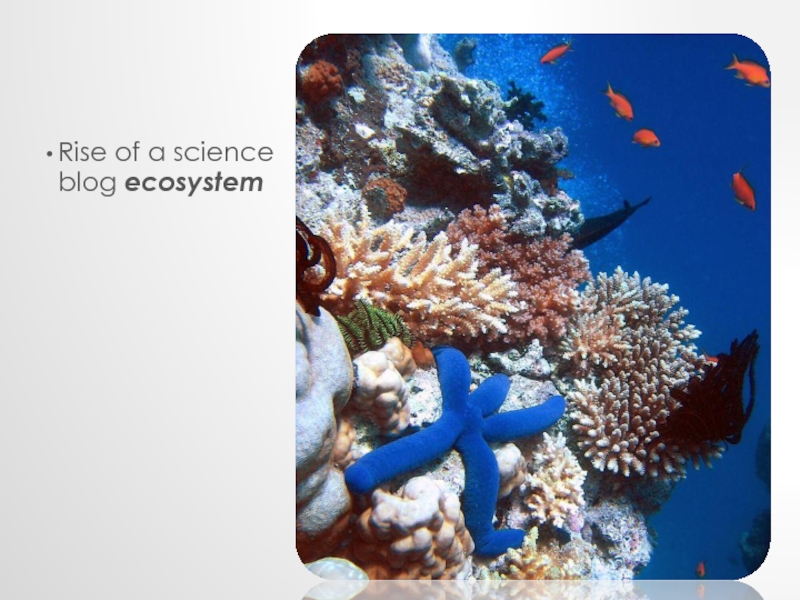
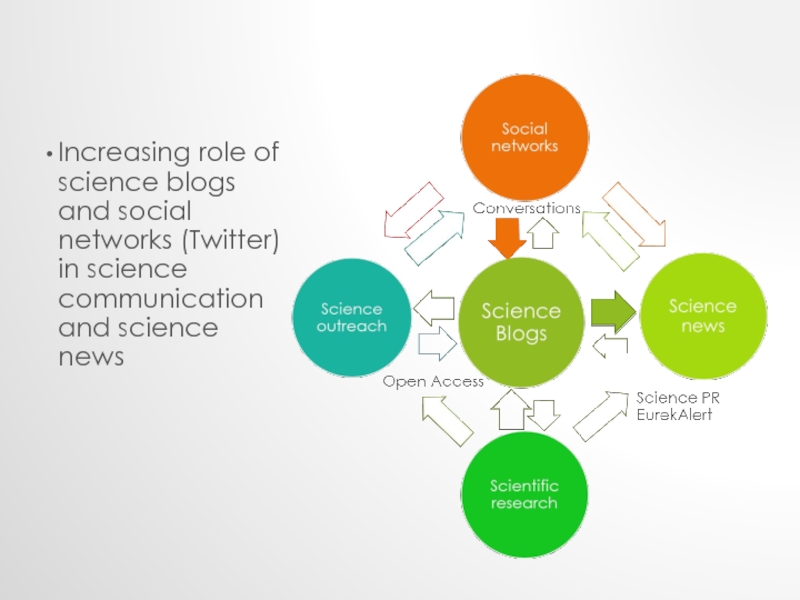
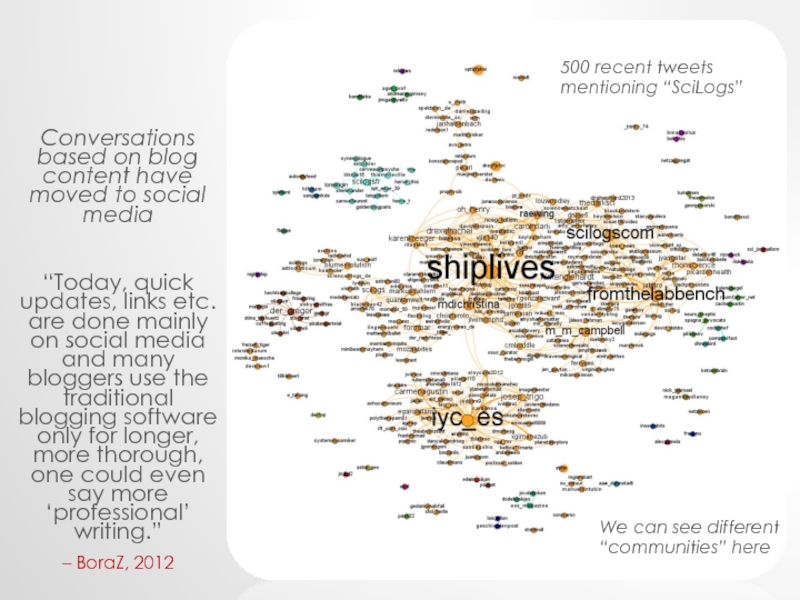
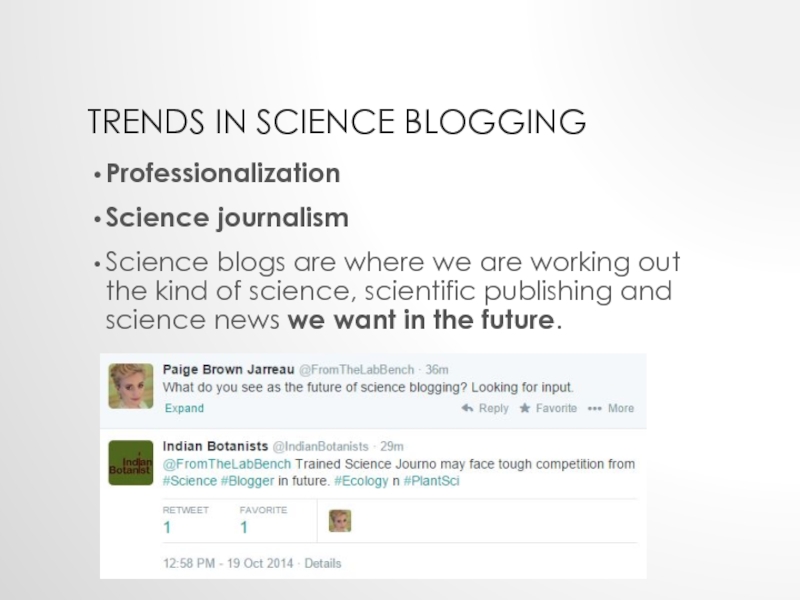
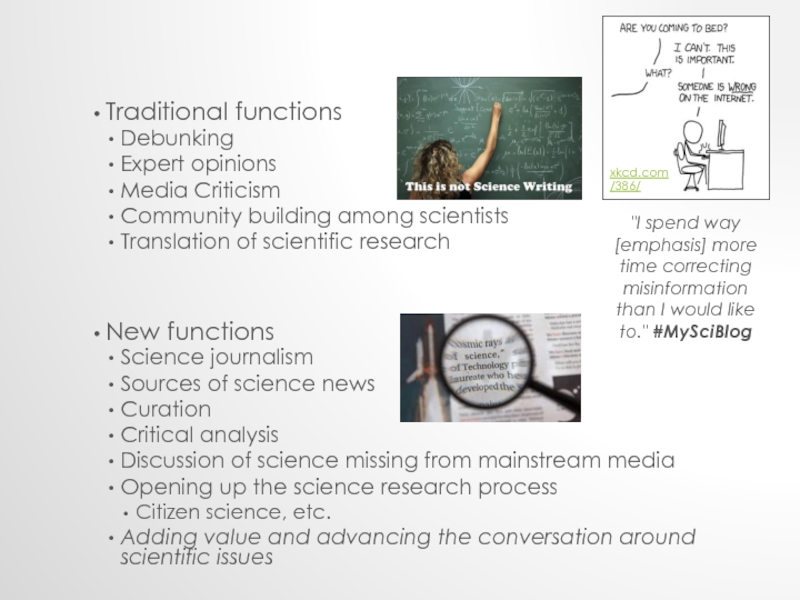
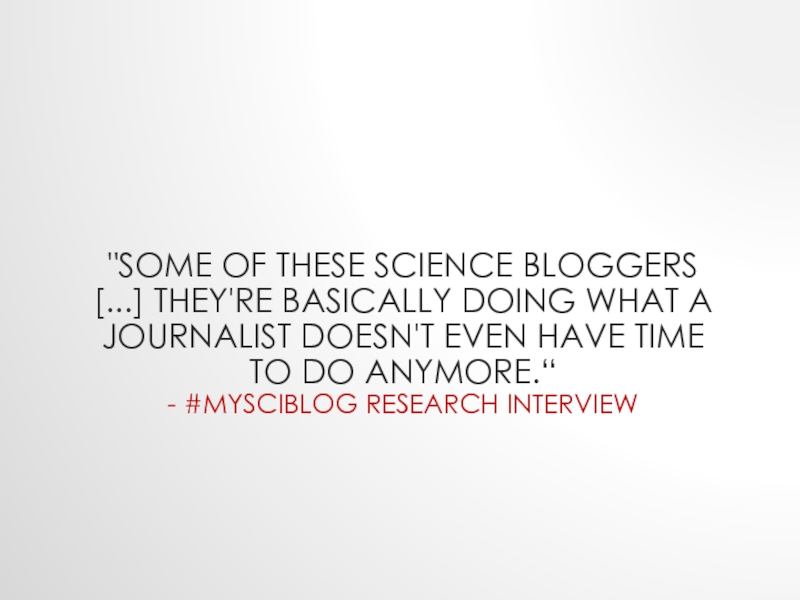
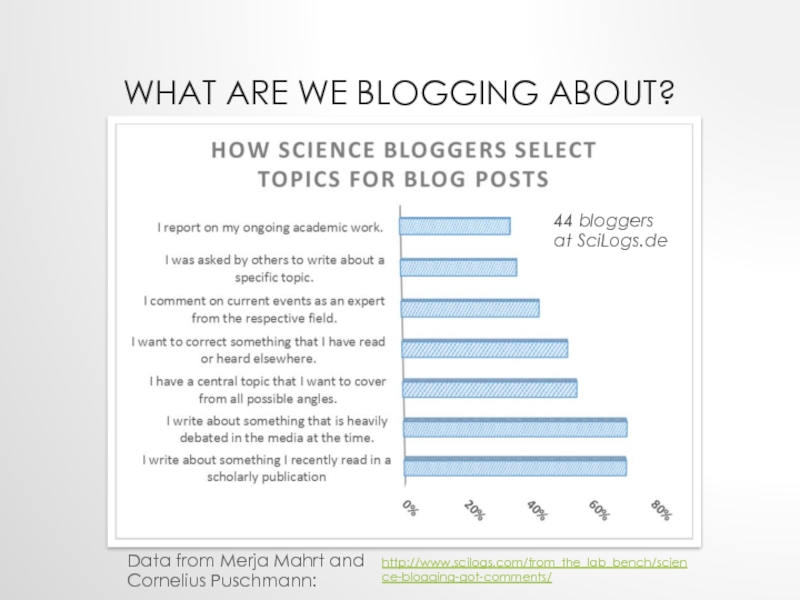
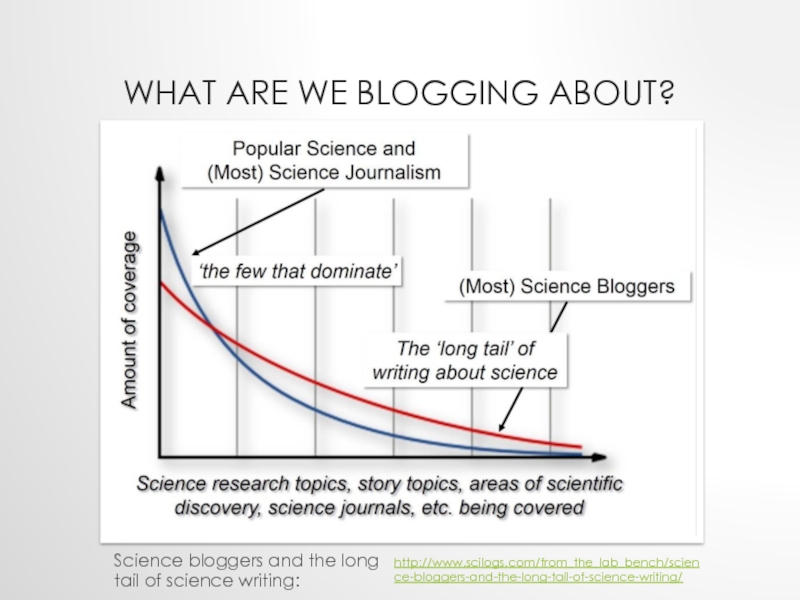

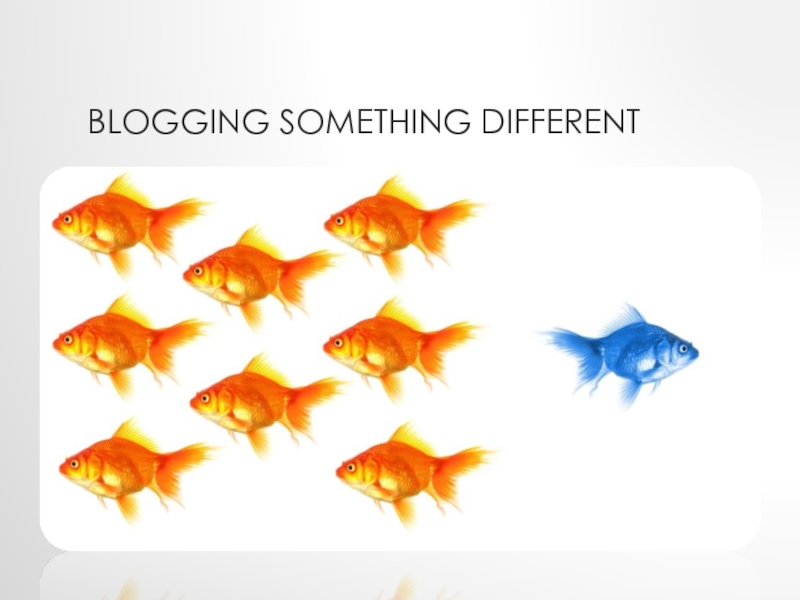
![BLOGGING SOMETHING DIFFERENT“[But]](/img/tmb/1/90809/bfe0b2fb5c62857fc895197db4caadd5-800x.jpg)
